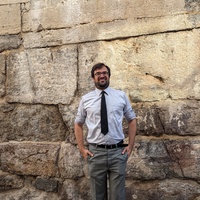
Aaron Koller
Related Authors
Noel B. Salazar
KU Leuven
John Huehnergard
The University of Texas at Austin
Ian Young
Australian Catholic University
Na'ama Pat-El
The University of Texas at Austin
Ahmad Al-Jallad
Universiteit Leiden
Eric H Cline
The George Washington University
Juan Manuel Tebes
Pontificia Universidad Católica Argentina
Filippo Carlà-Uhink
Universitaet Potsdam
Lamont Conyers
Faith Theological Seminary
Raymond C . Van Leeuwen
Eastern University
InterestsView All (45)










Uploads
Books by Aaron Koller
Papers by Aaron Koller
NOTE: This was chosen as the forum article for the journal, and so includes learned responses by Alice Mandell, Na'ama Pat-El, Seth Sanders, K. Lawson Younger, and Christopher Rollston, as well as my reply to their commentaries.
perhaps hundreds of works of literature, in Aramaic and Hebrew,
some of which no doubt were read by Jews (and perhaps others)
from Egypt through Persia. Using the data from the Dead Sea Scrolls and late biblical texts, we can reconstruct some of the pathways through which this literature traveled, and even surmise to some extent what it may have looked like.
https://www.openbookpublishers.com/product/1392, where the entire open access volume can be downloaded for free.
NOTE: This was chosen as the forum article for the journal, and so includes learned responses by Alice Mandell, Na'ama Pat-El, Seth Sanders, K. Lawson Younger, and Christopher Rollston, as well as my reply to their commentaries.
perhaps hundreds of works of literature, in Aramaic and Hebrew,
some of which no doubt were read by Jews (and perhaps others)
from Egypt through Persia. Using the data from the Dead Sea Scrolls and late biblical texts, we can reconstruct some of the pathways through which this literature traveled, and even surmise to some extent what it may have looked like.
https://www.openbookpublishers.com/product/1392, where the entire open access volume can be downloaded for free.
kingship differed deeply from their Mesopotamian counterparts. In Iron Age Levantine cultures (including Aramean,
Phoenician, and Israelite), the throne was a far more potent symbol of the monarchy than was the crown, as is reflected
in the iconography, and especially in texts. Phoenician and Aramaic royal inscriptions, as well as biblical texts, show
that the preeminent regalia of royalty in the region were not crowns, but thrones and “shoots,” or scepters. This paper
draws on epigraphic, visual, and literary materials from the Levant, as well as comparative evidence not only from
Mesopotamia, but also from Egypt and the Hittite world to emphasize the significance of the image of the throne in
constructing the image of the monarch in the Levant.
We follow the alphabet, from its invention through its diffusion across the Near East and eastern Mediterranean, as it spread among scribes.
little? Researchers have been led to wonder whether the alphabet may not have been as revolutionary as had been
thought, or perhaps that it was not invented as early as had been thought. Recent discoveries, however, coupled with
a re-evaluation of data that has been long known, lead to a different conclusion: the alphabet did spread across the
entire Near East, from Egypt, through Syria, into southern Mesopotamia, within a few centuries of its invention. The
exact chronology differed from place to place, but the transmission is always seen to follow the opening of trade routes.
Interestingly, the alphabetic script is typically seen in the hands of scribes, not formerly illiterate people. Thus the
alphabet’s revolutionary impact was limited by class structures, not geography.